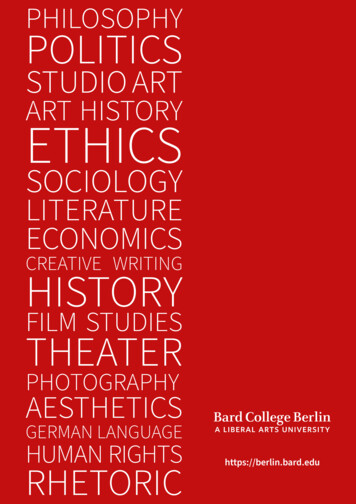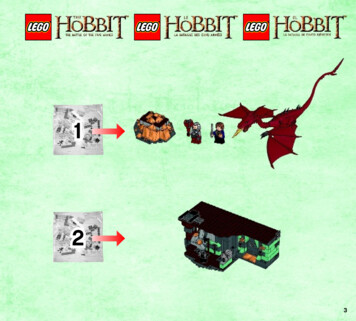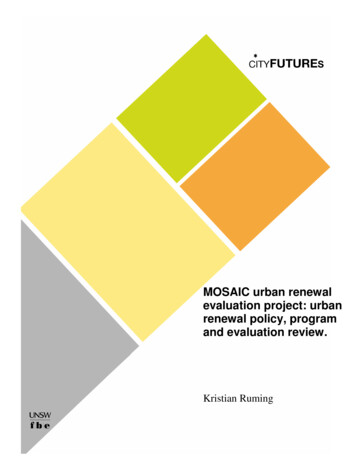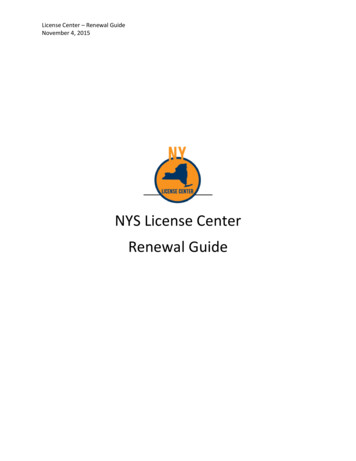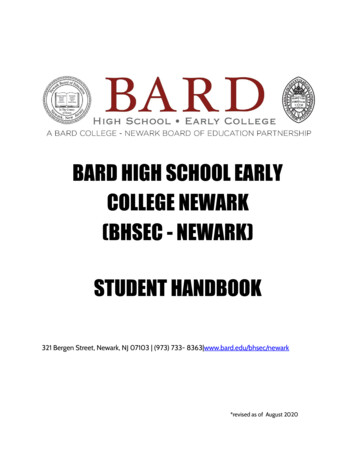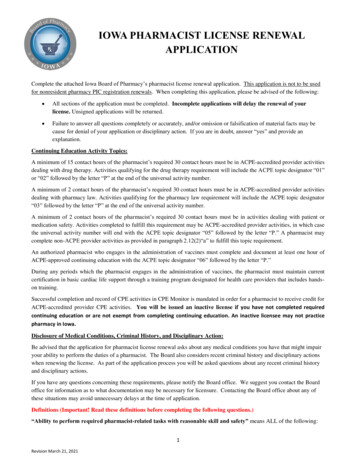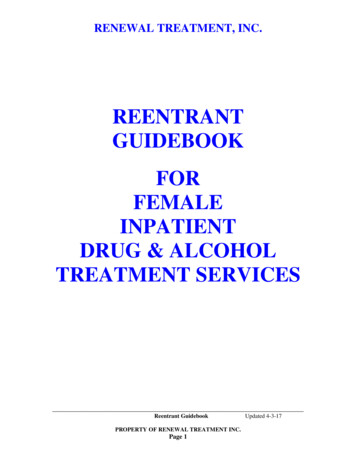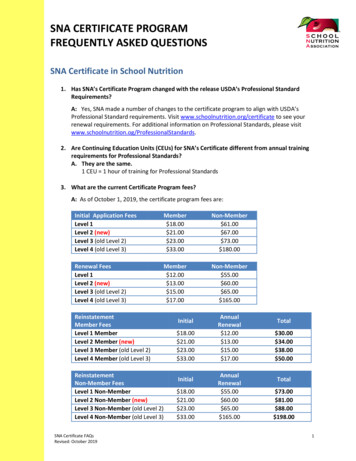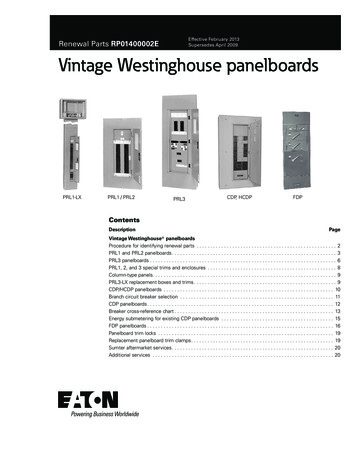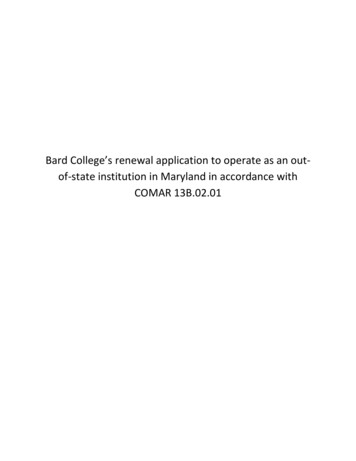
Transcription
Bard College’s renewal application to operate as an outof-state institution in Maryland in accordance withCOMAR 13B.02.01
DocuSign Envelope ID: E4AE2086-15E1-4F33-8213-FC5AF6472EFEOOS RENEWALMARYLAND HIGHER EDUCATION COMMISSIONApplication for Renewal Approval for Out-of-State Degree-GrantingInstitutions to Operate in MarylandPlease Note: A separate application form must be completed and submitted with allsupporting documentation for each proposed location in Maryland. If an additional, newlocation is being proposed, an Application for Renewal of Approval must be submitted forthat location.PREVIOSLY APPROVED LOCATION IN MARYLAND.Please provide the complete mailing address.Bard High School Early College Baltimore, 2801 N. Dukeland Street, Baltimore, MD, 21216PROPOSED START DATE OF CONTINUED OPERATION. August 31, 2020Applications should be submitted at least 5 months prior to the proposed start date.NAME AND ADDRESS OF INSITUTION APPLYING FOR APPROVAL.Name of Institution:Bard CollegeWeb Address:bard.edu, bard.edu/earlycollege, bhsec.bard.edu/baltimoreOPEID Code:002671U.S. Department of Education, Office of Postsecondary Education, ID Code -- Title IV eligibility.Chief Executives Officer: Leon Botstein, PresidentMailing Address:Bard College, Office of the President, 30 Campus Road,Annandale-on-Hudson, NY uInstitutional Liaison: Name and title of the individual who will serve as liaison to the Maryland HigherEducation Commission:Name: Clara Haskell BotsteinTitle: Associate Vice President for Early CollegesMailing Address:Bard High School Early College, 2801 N. Dukeland Street,Baltimore, MD, 21216Telephone:914-388-0699Email: cbotstein@bard.eduOOS Renewal 20121
DocuSign Envelope ID: ******************** CERTIFICATION ****************************I hereby affirm that the answers given in this application and its attachments are accurateand complete and further agree to comply with the Annotated Code of Maryland andState regulations governing the operation of out-of-State degree-granting institutions(COMAR 13B.02.01).7/1/2020DateSignature of Chief Executive OfficerPlease Submit All Information To:Maryland Higher Education CommissionDivision of Planning and Academic Affairs6 N. Liberty Street, 10th FloorBaltimore, MD 21201410-767-3268acadprop@mhec.state.md.usA copy of these regulations can be found at the Maryland Higher Education Commission’s web sitewww.mhec.state.md.us (under Academic Approval Process) along with an on-line application *****************************************I. DURATION OF APPROVALApproval to operate at a previously approved location in Maryland must be renewed annually. However,“during of after the fifth year of operation in Maryland and during any subsequent renewal cycle, an out-ofState institution may apply for approval to operate in Maryland for an extended period of time up to 5years.” COMAR 13B.02.01.08C(1)If the location for which you are applying has been annually approved for at least five years, do youwish to seek approval to operate in the State for an extended period of time of up to 5 years?Yes, we wish to be approved for years.II. SUPPORTING DOCUMENTATIONOnly a complete application can be acted upon. While separate application forms must be completed andsubmitted for each approved location, the following Supporting Documentation needs to be included onlyonce for each entire package of applications. CHECK EACH ITEM AS ATTACHED.Catalogs and Other Institutional Publications. COMAR 13B.02.01.20A(1)Have your catalogs, other institutional publications, or awards changed since they were lastsubmitted?YesNo If yes, please submit new copies.Application Fee. (Must accompany all renewals) COMAR 13B.02.01.08B(2)The institution shall submit a non-refundable application fee in the amount of (a) 7,500 for up to twodegree programs and (b) an additional 850 for each degree program over two programs. TheOOS Renewal 20122
DocuSign Envelope ID: s check should be made payable to: Maryland Higher Education Commission. Theapplication renewal fee will be waived for renewals of out-of-state institutions operating at RegionalMaryland Higher Education Center.Accreditation. (Must accompany all renewals) COMAR 13B.02.01.08B(4)(g)Provide a copy of the most recent letter of approval (notification) from an organization recognized asan accrediting agency by the U.S. Department of Education. Along with your most recent notificationof institutional accreditation, please provide evidence that you are in compliance with thatorganization’s policies and procedures related to off-campus educational activities. If any of yourproposed programs require program accreditation provide evidence of that accreditation.Registration as an Out-of-State Corporation. (Must accompany all renewals)COMAR 13B.02.01.08B(4)(f)To transact interstate business in Maryland, the institution must qualify with the State Departmentof Assessments and Taxation by making the certification required in the Corporations andAssociations Article, §7-202, Annotated Code of Maryland. A public institution is not required toqualify as a foreign corporation. However, a business entity affiliated with a public institution ora private institution (profit or non-profit) must qualify as a foreign corporation. The ForeignCorporation Qualification Form may be obtained from the Maryland Department of Assessmentsand Taxation, Room 809, 301 West Preston Street, Baltimore, Maryland 21201 or on-line at:www.dat.state.md.us. Once qualified, the institution must provide a copy of the certificate ofgood standing issued by the State Department of Assessments and Taxation.Certificate of Compliance With Fire and Safety Codes (Must accompany all renewals)COMAR 13B.02.01.08B(4)(o)Please provide a certificate for each approved location for indicating that the proposed facility hasbeen inspected and is found in compliance with local and State ordinances pertaining to fire andsafety.Board of Trustees Resolution of Financial Solvency (Must accompany all renewals)COMAR 13B.02.01.08B(4)(e)Please provide a resolution from your Board of Trustees addressed to the Secretary of HigherEducation stating that your institution is financially solvent.AdvertisementsCOMAR 13B.02.01.07D(3)(p)Are there new advertisements in print format related to your programs in Maryland?YesNo If yes, please provide copies of the new advertisements.Enrollment Data as Prescribed by the Secretary. (Must accompany all renewals)COMAR 13B.02.01.08B(4)(q)Please provide the information requested on the Student Enrollment Data Form found at the endof this application.Teach-out Plan (Must accompany all renewals) COMAR 13B.02.01.08B(4)(j)(iv)The institution must provide a copy of its teach-out plan allowing enrolled students to completetheir programs if the institution decides to cease operation in Maryland.OOS Renewal 20123
DocuSign Envelope ID: E4AE2086-15E1-4F33-8213-FC5AF6472EFEII. APPLICATION QUESTIONAIREThis questionnaire, properly completed with supporting documentation, shall serve as an application forapproval to operate in Maryland under the Code of Maryland Regulations (COMAR) 13B.02.01. It mustbe completed for each proposed location.1.Programs.Ø CURRENTLY OFFERED PROGRAMS.INSTRUCTIONS. Please enter the requested information on your CURRENTLY OFFEREDPROGRAMS in the spaces provided below, or create an attachment (labeled “A-1: CurrentPrograms”) to this application with the required information.(a) Provide a list of your currently offered programs at this location. For each program provide thefollowing information: (1) the full title of the program; (2) the degree or certificate to be awarded; (3) themode of instructional delivery; (4) the number of credit hours (semester or quarter); and (5) whether theyare offered at the parent campus.Program TitleDegreeMode ofInstructionExample: Organizational ManagementExample: Business AdministrationBard High School Early College (BHSEC) BaltimoreM.S.B.S.BAssociatein Arts(A.A.)ClassroomDistance Ed.Classroom,distance,hybridOOS Renewal 20124TotalCreditHours36 sem120 sem30 persemester; 60totalOfferedon MainCampusYes / NoYesYesCourserequirements for theA.A. atBHSECBaltimoreare thesame asthose forthe firsttwo yearsofundergraduate studyon BardCollege'smaincampus.The A.A.is offeredat otheradditionallocationsof BardCollege(including
DocuSign Envelope ID: uses)but not onBard'smaincampus(inAnnandale, NY).Instruction takesplacethroughmultiplemodes (inperson,distance,andhybrid)starting inSY 201920 as aresult ofCOVID19.Ø NEW PROGRAMSINSTRUCTIONS. Is the institution proposing any new programs at this location?YesNoIf yes, please enter the requested information in the spaces provided below, or create an attachment(labeled “A-1: New Programs”) to this information with your responses to the following for each newprogram:(a) Provide a list of the new programs at this location. For each new program provide the followinginformation: (1) the full title of the program; (2) the degree or certificate to be awarded; (3) themode of instructional delivery; (4) the number of credit hours (semester or quarter); and (5)whether they are offered at the parent campus.OOS Renewal 20125
DocuSign Envelope ID: E4AE2086-15E1-4F33-8213-FC5AF6472EFEProgram TitleDegreeExample: Organizational ManagementExample: Business AdministrationM.S.B.S.BMode ofInstructionClassroomDistance Ed.TotalCreditHours36 sem120 semOfferedon MainCampusYes / NoYesYes(b) If the information does not appear in the catalog or publication you submitted provide (1) adescription of the curriculum; (2) the objectives of each course; and (3) a course schedule for theproposed locationBackground on Bard and the Bard High School Early CollegesBard College (Bard) is an independent, non-profit, four-year college of the liberal arts and scienceslocated in Annandale, New York. Bard is chartered by the State of New York and accredited by theMiddle States Commission on Higher Education to offer an Associate in Arts (A.A.) degree, a Bachelorof Arts (B.A.) degree, and various graduate degrees.Bard has long demonstrated a commitment to supporting rigorous college programs for younger, highschool-age scholars. In 1979, Bard College assumed leadership of Simon's Rock College (now BardCollege at Simon's Rock)--the first private, residential early college in the country, established to servestudents after they completed the 10th grade. Early college is premised on the belief that manyadolescents are ready and eager for the greater challenge, scope, and rigor of a college education whilestill of high school age, and that early college can help ensure these students' success in their continuingcollege work after the A.A. degree and their ultimate engagement as active members of civil society andleaders in their fields. Simon's Rock is accredited by the New England Association of Schools andColleges (NEASC), Commission on Institutions of Higher Education.At the request of the New York City Department of Education, the leadership of Bard College andSimon's Rock jointly created the first Bard High School Early College (BHSEC), which opened in 2001.This school, now located in Manhattan, NY, was one of the first public early college high schools in thenation. Due to the success of the first BHSEC, the New York City Department of Education requestedthat Bard College open a second BHSEC in Queens, NY, in 2008. In 2011, then-Mayor Cory Booker ofNewark, NJ, invited Bard College to open a third BHSEC in Newark. Bard established a fourth BHSECin Cleveland in partnership with the Cleveland Metropolitan School District in 2014. Bard openedBHSEC Baltimore in partnership with Baltimore City Public Schools in August of 2015. Bard openedits newest early college campus, BHSEC DC, in partnership with the District of Columbia PublicSchools, in 2019.Through a collaboration between Bard College and the host public school systems, the BHSEC schoolsoffer their students two years of a college preparatory high school program that segues directly into atwo-year college course of study. The BHSEC academic program culminates in a state high schooldiploma as well as 60 transferable Bard College credits and an Associate in Arts (A.A.) degree fromBard College. The BHSEC schools function both as public high schools and accredited campuses ofBard College. The BHSEC schools in New York City are accredited as branch campuses of BardCollege at Simon's Rock through NEASC. The BHSEC schools in Newark, Cleveland, Baltimore, andOOS Renewal 20126
DocuSign Envelope ID: E4AE2086-15E1-4F33-8213-FC5AF6472EFEWashington, D.C. are accredited as additional locations of Bard College through the Middle StatesCommission on Higher Education.While more than 400 early colleges have been established around the country, the BHSEC schoolsremain unique in embedding a two-year, college degree-granting liberal arts and sciences programwithin a four-year, tuition-free public high school. The BHSEC schools are also among the few earlycollege high schools in which an independent college is the academic partner.The BHSEC schools have been remarkably successful. In the BHSEC Class of 2019 (including studentsfrom BHSEC Manhattan, Queens, Newark, Cleveland and Baltimore), 83% of graduating studentsearned an A.A. degree concurrently with a high school diploma, 96% of students earned at least oneyear of transferable college credit on average, and approximately 85% of BHSEC graduates continuedtheir education at four-year college or university.The BHSEC model has a strong evidence base demonstrating its effectiveness in helping students accessand complete college. In addition to internal evaluations, BHSEC has been the subject of severalindependent analyses. An independent, quasi-experimental study conducted by Metis Associates on theflagship BHSEC campuses in New York City found that BHSEC students were significnatly more likelyto complete bachelor's degrees than comparison students, matched by test scores, GPAs, anddemographic characteristics, who attended traditional public high schools and specialized and selectivepublic high schools, at a magnitude of 31 percentage points and 13 percentage points, respectively. Astudy by Metis Associates of BHSEC outcomes in Newark found that attending BHSEC Newarkboosted student enrollment in four-year colleges after high school. BHSEC Newark students were 12%more likely to enroll in four-year colleges upon completing high school than comparison students withthe same demographic, economic, and academic profiles who attended other Newark Public Schools. Inaddition, The Education Trust - New York found that, of all public high schools in New York State,BHSEC Manhattan and Queens had the highest rates of on-time bachelor's degree completion for lowincome students. Finally, the BHSEC model was the subject of a case study by Ithaka S R, a highereducation research group that coordinates the evaluation of the American Talent Initiative. The casestudy demonstrated the successes of early college, and BHSEC in particular, in expanding the collegeaccess pipeline. Ithaka S R found that early college is a viable and promising strategy for selectiveliberal arts colleges, with the important focus on hiring and training effective faculty, partnerships withschool districts, and balancing access and academic rigor in program admissions. Since 2003, BardCollege has awarded 3,493 A.A. degrees to BHSEC students.Bard High School Early College BaltimoreBard High School Early College (BHSEC) Baltimore opened in August of 2015 as a partnershipbetween Bard College and Baltimore City Public Schools. The school is a contract school and the firstearly college high school in Baltimore City. The school is located at 2801 N. Dukeland Street,Baltimore, MD, 21216. The school moved to this location in August of 2016. Starting in SY 2019-20, asa result of COVID-19, the school offers college classes through multiple modes, including in-person andthrough distance education.In the 2019-20 school year, BHSEC Baltimore serves 417 students: 93 in 9th grade, 122 in 10th grade,107 in Year 1 of the College program (in place of the traditional 11th grade), and 95 in Year 2 of theCollege program (in place of the traditional 12th grade). The maximum enrollment capacity at BHSECBaltimore is 450 students. In the 2019-20 school year, BHSEC Baltimore employs 28 full-time facultymembers and 2 adjunct faculty members. 22 members of the faculty teach in the college program, andthe majority of them (77%) hold terminal degrees in their fields of study. In the Class of 2019, the firstclass to graduate from the school after four years in the program, approximately half of all studentsearned an Associate's degree, and nearly 85% earned at least one year of college credit. Bard Baltimoregraduates have continued their education at a wide range of colleges and universities, including JohnsHopkins University, University of Pennsylvania, Goucher College, McDaniel College, Bowie StateUniversity, Morgan State University, University of Maryland, and UMBC. Bard Baltimore was renewedfor a five-year term (the maximum it could have received) in February 2020 by the Baltimore CityOOS Renewal 20127
DocuSign Envelope ID: E4AE2086-15E1-4F33-8213-FC5AF6472EFEBoard of School Commissioners. A copy of Bard's renewal application is included as Appendix I, andthe renewal report from Baltimore City Public Schools is included as Appendix J.Curriculum OverviewIn order to receive the Bard College Associate in Arts degree, students must maintain a 2.0 GPA, earnno less than 60 college credits, and fulfill the requisite distribution requirements (outlined below). Of the60 college credits required for the A.A. degree, 45 must be earned in the sequences of classes describedbelow. The remaining credits can be earned in classes chosen from elective courses offered by theScience, Mathematics, Languages, Literature, Social Science, and Arts departments. Courses withindisciplines are subject to change.Curriculum RequirementsAll four semesters of the Seminar Sequence at 3 credits each (12 credits);Two semesters of laboratory college science at 4 credits each (8 credits);Two semesters of college mathematics at 3 credits each (6 credits);Two semesters of college foreign language at 4 credits each (8 credits);Two semesters of literature and history/social science at 3 credits each (6 credits);One semester of music, theater, dance, and/or visual art (3 credits);Four semesters of College Experience at 1 credit each (4 credits).See Appendix A for course descriptions for the general education requirements at BHSEC. SeeAppendix B for syllabi for the college courses offered at BHSEC Baltimore in SY 2019-2020.(c) Please provide a brief description of the student population to be served by the proposed newprograms.The students at BHSEC Baltimore come from across Baltimore City. In the 2019-20 academic year, theschool served 417 students from across Baltimore City, 93 in the 9th grade, 122 in the 10th grade, 107 inYear 1 of the college program (in place of the traditional 11th grade), and 95 in Year 2 of the collegeprogram (in place of traditional 12th grade). Students came from approximately 50 middle and highschools and over 20 zip codes, representing the great diversity of Baltimore City. 86% of BHSECBaltimore students identify as Black, 10% as White, 3% as Hispanic, 1% as Other. All students receivefree meals, per the school district's policy. BHSEC has assessed over 300 applications as of March 2020for 125 seats in the 9th grade class entering in Fall 2020.BHSEC students are admitted through a qualitative assessment process that includes an interview and awriting assessment. The admissions process is designed to gauge students' motivation, intellectualcuriosity, and interest in an early college program of study. The admissions process for the 9th grade,the primary entry point to the school, does not include a review of students' prior academic records ortest scores. In keeping with the school and the school district's goals, BHSEC seeks students from awide range of backgrounds, including students who are the first in their families to attend college andstudents who have not previously attended Baltimore City Public Schools. Modifications to theadmissions process and to the ways in which students can access the program may be made with theapproval of Bard College and Baltimore City Public Schools.The primary entry point to BHSEC is the 9th grade, although transfer students may apply at any gradelevel. Any student residing in Baltimore City is eligible to apply.2. Educational Need. Before the Commission may evaluate the readiness of an out-of-State institution tooperate or award new degrees in the State, including the offering of an instructional program or a degreelevel not previously approved, the institution shall present evidence demonstrating the educational need toestablish operations, offer programs, and award the degrees in question in the State. In addition, the out-of-OOS Renewal 20128
DocuSign Envelope ID: E4AE2086-15E1-4F33-8213-FC5AF6472EFEState institution shall demonstrate that the proposed program, for which the institution is makingapplication, meets a critical and compelling regional or Statewide need and is consistent with the MarylandPostsecondary Education. COMAR 13B.02.01.06A&CINSTRUCTIONS: Please enter the requested information in the spaces provided below, or create anattachment (labeled “A-2: Educational Need”) to this application and respond to the followingquestions for each new program:(a) What critical and compelling Regional or Statewide (Maryland) need and demand do your proposedprograms meet? In responding to this question provide documentation as indicated below:(1) If the programs serve occupational needs, present data projecting market demand and theavailability of openings in the job market to be served by the new programs for which theinstitution is making application. This information may include workforce and employmentprojections prepared by the federal and State governments, the availability of graduates in theState or region, marketing studies done by the institution or others, and material from professionaland trade associations.BHSEC Baltimore fulfills a regional and statewide need to increase the number of students whograduate with a postsecondary degree. According to the Maryland Department of Labor's 2008-2018occupational projections, 77% of anticipated job openings in Maryland will require postsecondarytraining or education beyond high school. Currently, college completion rates are not sufficient to meetthe needs of the workforce. According to Complete College America, of the students who matriculate tocollege in Maryland, 63.1% of students entering an associate's degree program require remedialeducation, and only 12.7% of full-time students earn an Associate's degree in three years. Only 63.5% ofstudents at non- flagship four-year Institutions of Higher Education earn a degree in six years.In Baltimore, the need for higher college completion is even greater. On average, in Baltimore, about56% of recent graduating students have enrolled in college immediately after high school graduation.Approximately 44% of Baltimore City Public School graduates who first enrolled in a four-year collegecompleted a bachelor's degree, and 5-6% of graduates who first enrolled in a two-year collegecompleted a college degree. (Baltimore Education Research Consortium, Baltimore City Schools,College Fact Book, January 2017).By allowing public high school students to complete up to two years of transferable college credit andan associate' s degree, free of charge, and within the four years of traditional high school, BHSECBaltimore helps students access college, avoid the need for remedial education, and complete collegedegrees, both associate's and bachelor's degrees, on time or early. By helping students complete collegedegrees, BHSEC Baltimore fulfills a key regional and statewide workforce preparation need.(2) If the programs serve societal needs (include the traditional liberal arts education), provide aDescription of how the proposed programs will enhance higher education in Maryland andcontribute societyBHSEC Baltimore fills an important societal need to increase college access, affordability, andcompletion for Baltimore City students.College AccessBHSEC Baltimore increases college access for Baltimore City students in a few key ways. For one, theschool provides high-school-age students with a two-year, degree-granting college course of study freeof charge. This opportunity for tuition-free college study during the four years of traditional high schoolprovides significant college access to high-school-age students. BHSEC also substantially increases thenumber of dual enrollment opportunities in Baltimore City. In 2014, only 55 Baltimore City PublicSchools high school students (out of a population of approximately 22,882) were also enrolled in collegeOOS Renewal 20129
DocuSign Envelope ID: E4AE2086-15E1-4F33-8213-FC5AF6472EFEcourses. (Baltimore Education Research Consortium, College Enrollment and Degree Completion inBaltimore City Schools, 2013.)Data demonstrates that dual enrollment - and early college in particular - significantly improvesstudents' likelihood of enrolling in and completing a college degree. For example, a 2014 experimentalstudy conducted by the American Institutes for Research (AIR) found that early college students aresignificantly more likely to enroll in college and complete college degrees than comparison peers whodid not attend an early college. Moreover, a 2019 AIR cost-benefit study found a total average return of 57,682 per Early College student compared with a 3,800 per student investment—a 15-to-1 return.(American Institutes for Research, Early College, Continued Success: Early College High SchoolInitiative Impact Study, January 2014; AIR, The Costs and Benefits of Early College High Schools,2019.)In addition, BHSEC's college counseling program, organized by the College Transfer Office and offeredover four semesters, helps students identify strong four-year college matches, prepare competitiveapplications, and transfer their college credits, or develop alternative postsecondary plans. Thus,BHSEC increases students' access to college after graduation as well as during the early college programitself. BHSEC students in the Class of 2019, the first graduating class to complete all four years atBHSEC, were accepted to nearly 90 different Institutions of Higher Education (IHEs), including fouryear public and independent colleges and universities in and out of state. Bard has formal articulationagreements in place for its early college high schools with Maryland colleges, including Bowie StateUniversity, Goucher College, McDaniel College, and Mount St. Mary's University, and is working onagreements with the University of Baltimore and the University of Maryland. The existing agreementsare included as Appendix C, and the list of four-year colleges that accepted students in the BHSECBaltimore Class of 2019 is included as Appendix D.College AffordabilityIn addition to inadequate college preparation and access, the cost of college is another reason somestudents do not complete college degrees. By allowing students to earn up to 60 college credits and anAssociate's degree free of charge, BHSEC Baltimore allows students to save a significant amount intuition and fees in pursuit of their college degrees. For BHSEC students transferring 60 college credits toa four-year public IHE in Maryland, the savings in tuition and fees will likely be above 20,000, inaddition to the added benefit of no debt burden for the first two years of college. (University ofMaryland, Office of the Bursar, Undergraduate Tuition, Fees, and Other Expenses.) These cost savingswill further increase students' chances of completing a bachelor's degree. BHSEC students also arecompetitive for scholarhips. Students in the BHSEC Baltimore Class of 2019 (75 graduating students intotal) received approximately 3.6 million in college scholarships.College CompletionPossessing a postsecondary degree increases lifelong earnings and reduces the risk of unemployment.(Census Bureau, Educational Attainment in the U.S.: 2009, 2012.) Median earnings of residentspossessing a bachelor's degree are 77% higher than those of residents with only a high school diploma.(Ibid.)The need for higher rates of college completion is particularly strong in Baltimore. As previously stated,approximately 5-6% of Baltimore City Public Schools graduates who first enrolled in a two-year collegefinished any type of degree, and approximately 44% of those who started in a four-year collegecompleted bachelor's degrees.In the BHSEC Baltimore Class of 2019, 48% of eligible students (who began the college program inFall 2017) earned the Bard College Associate's degree and 60 transferable college credits, and 84% ofthe graduating class earned a high school diploma and at least one year of transferable college credit onaverage. Approximately 62% of BHSEC Baltimore graduates continued their education at four-yearcolleges and universities. Other students continued at a community college or entered the workforce.Thus, BHSEC Baltimore fills an important societal need to increase college access, affordability, andcompletion among Baltimore City students. Furthermore, BHSEC students are prepared by theirOOS Renewal 201210
DocuSign Envelope ID: E4AE2086-15E1-4F33-8213-FC5AF6472EFErigorous liberal-arts-based early college training to succeed not only in four-year colleges, but also in awide range of careers, including medicine, law, business, and
At the request of the New York City Department of Education, the leadership of Bard College and Simon's Rock jointly created the first Bard High School Early College (BHSEC), which opened in 2001. This school, now located in Manhattan, NY, was one of the first public early college high schools in the nation.
